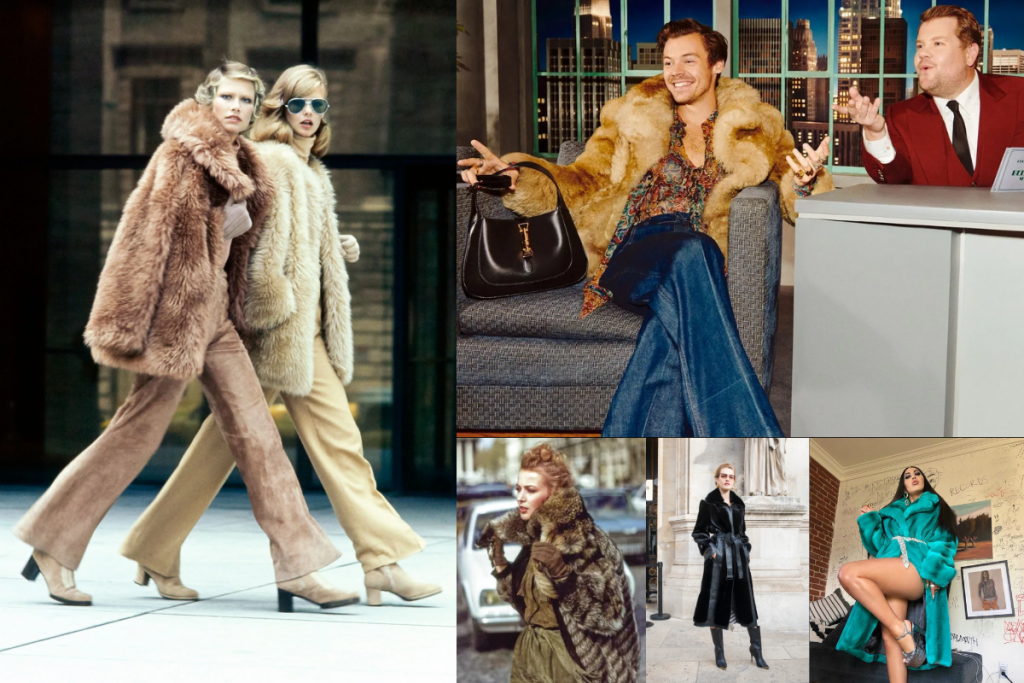
Fur has been a part of fashion for as long as fashion has been an industry. In 2017, the global sale for fur was $30 billion (WWD). That statistic really surprised me because, for the past decade, the use of fur is not looked at favorably, and you do not often see influential individuals wear real furs anymore. Gucci was one of the first luxury houses that abandoned the practice, followed by Versace, Burberry, Coach and Chanel (Vogue). London Fashion Week even banned their presence on its catwalks in 2018. These houses were known for their use of exotic skins, which made some of their products highly expensive and sought after. Now, products with real furs and skins are pretty much obsolete, and yet it is a $30 billion industry.
Vogue Arabia reports that fur was one of our first attires because it was soft and protected us from the elements. This makes the human connection to fur deeply ingrained and long-standing. The use of fur was necessary because it’s what kept us alive when we dealt with extremely cold temperatures. Fur was also seen as a trophy for the explorers to show the type of animals they had killed. Now, however, the use of fur is not necessary, but a way to show wealth and style. Fur has always been the not-so-subtle way of adding luxury to clothing pieces and outfits.
Many fur houses and companies are feeling the backlash from the use of fur by declining sales. These companies are investing in studies and marketing that suggest that fur is a more sustainable textile (Vogue Business). Some studies argue that fur is a natural material because it is biodegradable, renewable and reusable, which makes it “good.” But the cons absolutely outweigh the benefits in this subject. The animals from which this fur is taken are endangered or already extinct. The process of acquiring the fur is also very energy-intensive and uses a lot of resources.
“An increasing number of luxury brands and retailers ban fur and exotic skins, stock of “vegan” products has increased by 258% across the UK and US in 2019,” (Vogue Business). Fur, leather and other exotic skins are still very fashionable and have not gone out of style. Most industries are becoming “greener” and more sustainable in response to growing public concern. Like the rest of the fashion industry, the fur industry is also coming out with more sustainable options. Vegan leather and fur have now become just as soft as their real counterparts. Leather has always been marketed as a more durable material that can withstand wear and tear, and this was missing from its vegan counterparts. However, in recent products, I have seen the problem solved. Since creating vegan skins and fur are resource-intensive, companies have also started creating versions that are made of repurposed materials. Many people were not switching over to faux leather or fur because the real version was warmer, softer and more durable. Now, through technology, those problems have been fixed.
In the last decade, celebrity endorsement has greatly helped this movement. PETA started the “Naked” Campaign, where celebrities were photographed nude, covered only by a banner with the phrase, “I’d Rather Go Naked Than Wear Fur” on it. As soon as celebrities showed everyone that wearing fur and real leather was not the only way to appear wealthy and exclusive, a lot of the interest died down. And if you still want to own fur and not add to the cycle, you are able to purchase vintage furs. Due to the recent developments, people are buying second-hand fur coats, which allows them to achieve the look and not contribute to the fur industry.
My hope for the future is to completely move away from the fur and leather industry because the advancements of technology have allowed for fantastic and functional vegan alternatives. We do not need to kill innocent animals just so that we can appear “cool.”





















